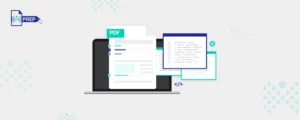Why is Digital Accessibility Important?
If you are not working towards making your digital content obtainable to everyone by enforcing digital accessibility, then you are leaving out at least 2.2 billion of the global population who have visual impairments.
What Makes Digital Content Accessible?
The WCAG (Web Content Accessibility Guidelines) has established a framework of four core principles, which serve as foundational pillars for ensuring inclusive design. These principles are encompassed by the acronym POUR:
- Perceivable – This principle emphasizes that the digital content is perceived by all users, regardless of whether they read the information or use assistive technology. For example, People with color vision deficiencies perceiving information in charts and graphs using alternative text descriptions.
- Operable – Operable content means users can successfully navigate through buttons, controls, and navigation tools without any hassles, even when they use assistive technologies like screen readers or Braille displays. For example, People with physical disabilities navigating through a website using voice commands.
- Understandable – This principle ensures that the user interface and digital content are easy for everyone to understand, no matter how they are presented. For example, People with cognitive disabilities understanding website instructions through clear and concise language.
- Robust – Robust digital content ensures compatibility with various devices and assistive technologies, making it easy for all users to access.
What is the Difference Between Web Accessibility and Digital Accessibility?
Why Should Businesses Focus on Digital Accessibility?
Today, digitally accessible content is not an option anymore. A business should be ADA-compliant regarding web accessibility. Not only is it a legal requirement, but as a business owner, it is also your ethical duty to make sure whatever content you put on the internet is non-discriminatory towards people with visual or cognitive impairments.
Digital accessibility is also known to be a proven strategy for operational success. In fact, 71% of the users with a disability will leave your website if it is not accessible.
- Improve User Experience – Accessible content is going to increase user experience for people with all abilities. It will make it easier for everyone to navigate and read text.
- Increase Sales Revenue – You lose many potential customers if you do not make your digital content accessible. And we are not talking about a few hundred, but significant population of people. It is believed that a business sees an increase in its sales revenue when there is an accessible design as it:
- Reaches a larger customer base
- Makes your site easier to use
- Improves your SEO rankings
- Drives innovation
- Eliminate Chances of Getting Penalized – In the United States, businesses must comply with the digital and web accessibility ADA.Your business will undergo costly lawsuits if you do not follow the rules and regulations set to make content accessible.
Incorporating Digital Accessibility
Previously, accessibility was only applied to physical, private, and public spaces. But today, as the world has taken a turn with the widespread of technology, it has expanded its wings to the digital world. Businesses, technologies, litigations, and others must push themselves further to achieve complete digital accessibility to stay inclusive and compliant with the laws. And as the internet continues growing to provide digital solutions, web developers need to level up and include elements of digital accessibility!
